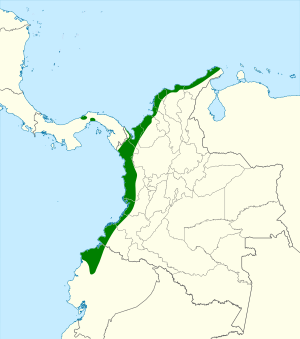Colombian crake facts for kids
Quick facts for kids Colombian crake |
|
|---|---|
| Conservation status | |
| Scientific classification | |
| Genus: |
Neocrex
|
| Species: |
colombiana
|
 |
|
| Synonyms | |
|
|
The Colombian crake (Neocrex colombiana) is a small bird that belongs to the Rallidae family. This family includes rails, crakes, and coots. You can find this bird in parts of Colombia, Ecuador, and Panama.
Contents
About the Colombian Crake
Scientists often study how different animals are related. For the Colombian crake, some experts place it in the Neocrex group of birds. Others, however, think it belongs in the Mustelirallus group, along with a bird called the paint-billed crake.
This article uses the Neocrex group name. The Colombian crake has two main types, or subspecies:
- N. c. colombiana (the main type)
- N. c. ripleyi
What Does It Look Like?
The Colombian crake is about 18 to 20 centimeters (7 to 8 inches) long. Both male and female birds look very similar.
The main type, N. c. colombiana, has a brown top of its head, neck, and back, including its tail. Its throat is white, and its face, chest, and upper throat are gray. The sides of its body, belly, and under its tail are a cinnamon color.
The other type, N. c. ripleyi, looks similar but is much darker in color.
Where Does It Live?
The N. c. colombiana subspecies lives in northern Colombia and goes south into northwestern Ecuador. The N. c. ripleyi subspecies is found from central Panama into northwestern Colombia.
Scientists don't have many records of this bird, so they aren't completely sure about the exact areas where each subspecies lives.
The Colombian crake likes wet or moist places. These can include:
- Marshes
- Swamps
- Savanna (grasslands with scattered trees)
- Brushy edges of forests
Some of these places might not have open water. This bird can live from sea level up to about 2,100 meters (6,900 feet) high.
How Does It Behave?
Movement
The Colombian crake is thought to be a "sedentary" bird. This means it usually stays in one area and does not travel far or migrate.
Feeding Habits
We don't know much about what the Colombian crake eats or how it finds its food. However, scientists think its diet and feeding habits are similar to its close relative, the paint-billed crake.
The paint-billed crake looks for food in:
- Soil
- Fallen leaves
- Shallow water
It has been seen feeding in open areas next to thick plants, especially around sunrise and sunset. It eats small creatures without backbones, like millipedes and beetles, and also seeds.
Breeding
The breeding season for the Colombian crake seems to be from at least December to February. Beyond that, not much is known about how these birds raise their young.
Sounds It Makes
As of late 2022, there was only one recording of a Colombian crake's sound on a website called Xeno-Canto. The Macaulay Library, another bird sound archive, had none. The single recording is of a young bird making a distress call while being held by a researcher.
What Is Its Status?
The IUCN (International Union for Conservation of Nature) keeps track of how threatened different species are. They first listed the Colombian crake as "Near Threatened" in 1988. Then, in 1994, they said its status was "Unknown." Since 2000, it has been listed as "Data Deficient."
"Data Deficient" means that there isn't enough information about the bird to know if it's in danger or not. Scientists say that we need to learn more about this bird's status, where it lives, and its natural habits. Even so, it seems there are still many good places for the main subspecies to live in western Colombia and Ecuador.
See also
 In Spanish: Polluela colombiana para niños
In Spanish: Polluela colombiana para niños


